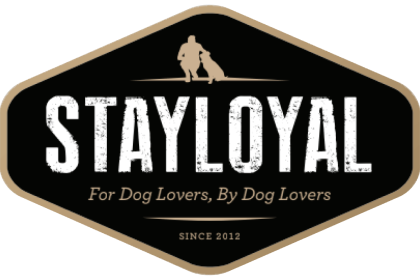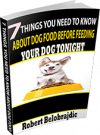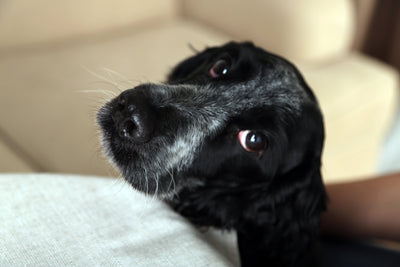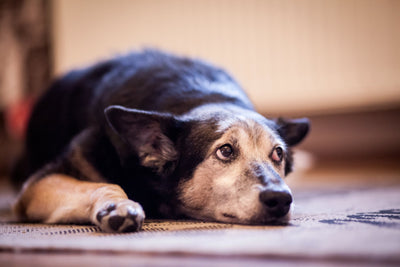Should I Feed Raw Chicken to my Dog?
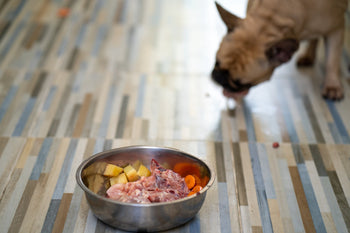
Back in 1993 a veterinarian here in Australia named Ian Billinghurst decided that pet dogs would benefit from a raw-based diet. Working dogs, such as racing greyhounds and sled dogs, have been fed raw-based for decades and he thought that house dogs would be healthier on a similar diet. Thus, the BARF – Bones and Raw Food – diet was born.
Since then, there has been huge debates on the safety of different aspects of raw diets (BARF or otherwise), especially when it comes to bones, chicken in particular.
If you are thinking about feeding chicken bones as a supplement to your dog’s diet, here are things to consider.
The Benefits
Billinghurst first decided to develop a raw feeding plan because he truly believed it would benefit household pets to have some raw food in their diet – after all, they are descendent from wolves, which only eat raw. Even if you feed kibble, which is far easier and cost effective than a 100% raw diet, many veterinarians and nutritionists recommend adding fresh veggies and fruits to your dog’s meal, as well as raw meaty bones, due to the benefits.
Nutrition. Raw chicken bones are full of minerals, including calcium phosphate, which your dog needs for proper skeletal system growth and repair. And, the calcium found in bones is four times more digestible than those found in supplements, so it’s a far more effective way to make sure your dog is getting enough calcium (Stay Loyal already has calcium from bones in the Chicken meal.).
Teeth Cleaning. Chewing on raw bones helps clean your dog’s teeth in a natural way that kibble does not. Fed after a meal, they stimulate saliva enzymes that break down tarter build-up and trapped food particles, which cause gingivitis (80% of dogs over 3 years old had dental disease!) and bad breath.
Helps Dislodge puppy teeth. A lot of dental issues due to puppy teeth not leaving the gums can be avoided by giving puppies raw meaty bones to chew on while teething. They help get the dead puppy teeth out, allowing the new teeth to grow in the right position.
Satisfies the Need to Chew. All dogs need to chew, it’s part of their DNA. Giving them something appropriate to chew on saves your shoes, books and furniture.
The Risks
First, while this is an article on RAW chicken bones it’s important to note that COOKED chicken bones are far more dangerous. Cooked bones become hard, which can break teeth, and are brittle. Brittle bones can easily splinter, causing not only choking hazards, but if swallowed can puncture internal organs and are more likely to get stuck in the throat due to their sharp edges. Raw bones are soft, and less likely to splinter, break teeth or get stuck on the way down.
Choking. That said, your dog could still choke on a raw chicken bone, though most stories in articles on chicken bones either do not mention if the bone was raw or cooked, or it ends up being that it was a cooked bone that the dog got out of the trash or was fed as a left over after a human meal. The main thing about choking is to make sure you are giving your dog an appropriately sized bone. As an example, a larger dog is more likely to choke on a bone they try to swallow whole that was maybe too small for them. It’s also a good idea to supervise your dog while he is eating, so you can notice if he is trying to gulp, rather than chew, the raw bone.
E. coli, Salmonella, etc. Another risk often mentioned are the risks of the dog getting sick from bacteria, like E. coli and salmonella, on the meat. And it is possible for even humans to get sick while handling the bones, dishes, etc. This is true. However, dry and canned dog food can also have these bacteria, and many health experts recommend people (especially children, those with low immune systems and the elderly) exercise the same cautions of washing after handling their dog’s food and dishes, even with a commercial dry or canned diet. In 2006, a study was done to see if E. coli and salmonella were more prevalent in commercially packaged raw meat diets vs. commercially canned food. In the 20 raw meat diets they sampled, they found 7.1% contained a type of salmonella and 59.6% contained E. coli bacteria. The study found E. coli in 100% of the commercially processed, cooked foods during one of the four sampling periods and in one commercial dry food.
Acute polyradiculoneuritis (APN). APN is a rare inflammatory condition where the back end of the dog becomes weak, eventually becoming paralyzed. It can move into the front of the dog, including legs, head and neck. Dogs can die from APN should their chest become paralyzed. However, with treatment, most dogs recover in about six months. In the United States, it’s referred to as “coonhound paralysis” because it was believed to be contracted through racoon saliva originally. Though many cases have been found where dogs did not have contact with raccoons, the term is still used.
The University of Melbourne has been working on what causes APN. Matthais el Chevoir, chief investigator on the project at the University says they see about 30 cases a year, with 3 in 10 not recovering. The University has been working on whether dogs fed raw chicken are more at risk for APN, because raw (undercooked) chicken contains the bacteria Campylobacter, which has been found in 40% of humans with the same disease (Guillian-Barre Syndrome). It’s also found in unpasteurized milk products and contaminated water. Their sample study included 27 dogs with APN Symptoms and 47 dogs without. They found that dogs showing signs of APN were 9.4 times more likely to have Campylobacter in their body, then the dogs without any APN signs. As a side note, they also found that smaller dog breeds seem to be more likely to have the disease, they believe it’s because dog owners are more likely to feed them small chicken bones, versus other raw meats.
So What’s the Verdict?
Like most things in life, there are risks and benefits to feeding raw bones. For the most part, if you are making sure your dog is eating a RAW, appropriately sized bone and is truly chewing, not gulping, he should avoid any risks associated with choking or splinters, while reaping the benefits of cleaner teeth and stronger bones.
Salmonella and Camplyobacter are bacteria found everywhere, Camplyobacter is actually found in intestinal tracts of cats, dogs, poultry, cattle, swine, rodents, monkeys, wild birds, and some humans.
Salmonella is found on living animals, including reptiles and amphibians, as well as eggs, and even fruits and vegetables. So you really can't escape these bacteria even if you don't feed your dog any raw meat. And, remember your dog’s stomach and immune system is much stronger than yours, they are made to deal with more bacteria than ours. While APN is a risk, it’s a rare one that can come from other sources as well.
In the end, it’s up to you to weigh the risks and benefits and decide what is best for your dog.
